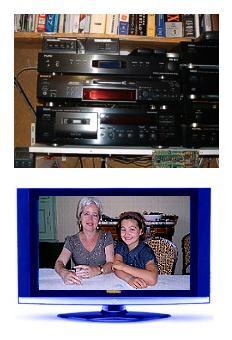Our Voltimum Experts answer your questions on a daily basis in our Technical Expertise area. This one, about electrical testing, and why Class 2 metal-cased AV equipment in a home has 130V casing touch voltage, is answered by Intertek:

Question: My wife recently discovered this problem when she received an electric shock from a new flip-down under unit metal cased LCD TV, whilst turning it off at the same time as turning off our extractor hood in the kitchen. As I am an experienced NICEIC approved electrical contractor, I went about testing and found 95V at 50Hz between the metal case of the TV and earth!
The TV is supplied by a 12V double-insulated powerpack and, therefore, I believe it to be Class 3. This made no sense to me, so I continued to test at the co-ax aerial outlet and found that all metal-cased equipment that was connected to the aerial network had a similar case voltage ranging from the highest at 128.8V and 85V on the lowest with respect to earth.
I have disconnected all appliances from the aerial network and any other interconnections, then re-tested with the same results - in total, there are four Class 2 appliances and one class 3. All have high AC case voltages with respect to earth. I believe that they all have switched mode power supplies, although I have limited knowledge of these.
I then PAT tested the appliances - all results were OK, with negligible touch currents and high insulation resistance values.
I have spoken with the suppliers and manufacturers of the various appliances, and even sent one appliance (a surround-sound entertainment system) away to be independently tested. It was returned as being OK. When I spoke with the test company, they have said that although they replicated my test and saw approximately 130V, when they introduced a shunt circuit in parallel with the voltmeter, the voltage was dissipated. I replicated this using components to their specification and, sure enough, the voltage is dissipated.
I am not convinced however that this is a sufficient explanation for equipment that emits electric shock; people don't have capacitors and resistors connected to their fingers!
The NICEIC helpline advised me to get the PME electricity supply tested in case of a breakdown on the incoming neutral. I had already carried out earth and line loop tests and found good readings, but I called out the electricity board on the helpline's advice. The engineer carried out earth and line loop impedance tests and said that the supply was OK, even though he only tested at an instant in time.
I can only think that there is some kind of RF filter that is using the case/carriage as a common rail and dropping voltage to it. Any information would be greatly appreciated.
Many thanks
Ian Duddridge
ID Electrical
Answer: This is not an uncommon problem! It is, in fact, a common problem with no real answer. There have been International conferences where this has been discussed with no resolution.
The problem is caused, in the main, by Class II metal cased products that have small capacitors connected to the metal case for EMC purposes. There are limits for the touch current that are part of the safety standards but, as soon as you connect more than (say) three boxes together, the touch current voltage can increase cumulatively to a noticeable level. The first notion is to earth everything, but you may as well shout I'M HERE to any passing thunderstorm because this could effectively turn your TV and satellite aerials into lightning conductors!
I think you need to be a bit careful about using the shunt circuit because I'm unsure whether this may make the system more sensitive to spikes on the mains, or even reduce the antenna impedance to a point where it looks earthy to a lightning voltage. Without conducting some expensive tests, it is difficult to know what the effects are on your system, but equally it could be OK.
The problem may be made worse by the aerial distribution system, because this effectively connects all the different products in the house together. You can obtain isolated distribution systems, mainly used for professional use in blocks of flats etc, but these are expensive. However, although these overcome the problem of adding all the different boxes on a distributed system together, it doesn't overcome the problem of a centralised system that may have, for example, TV, satellite box, digibox, HI FI equipment etc, all connected together in the same position, and all adding a little more to the touch voltage. The only real way to reduce this effect is to reduce the number of boxes connected together, but this is difficult with the complexity of systems we now use.
Although the voltage appear high, the current behind this is very small and, although you can get a shock, there is unlikely to be enough current available that could cause any serious injury because the voltage would drop away very quickly. I have a very complex system in my house with a touch voltage of about 215V - and that bites, especially when you remove a SCART lead and forget to un-plug all the equipment!
To see many more Q & A in Voltimum UK's Experts Area, please click on the link:
https://www.voltimum.co.uk/consult.php?universe=consult.index.questions